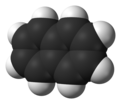Coal tar is a thick dark liquid which is a by-product of the production of coke and coal gas from coal. It is a type of creosote. It has both medical and...
36 KB (3,474 words) - 08:35, 3 June 2024
through destructive distillation. Tar can be produced from coal, wood, petroleum, or peat. Mineral products resembling tar can be produced from fossil hydrocarbons...
14 KB (1,532 words) - 07:27, 23 August 2024
Creosote (redirect from Coal-tar creosote)
The two main kinds recognized in industry are coal-tar creosote and wood-tar creosote. The coal-tar variety, having stronger and more toxic properties...
95 KB (10,395 words) - 20:07, 8 August 2024
chemical industry with a wide range of artificial dyes being made from coal gas and coal tar. Facilities where the gas was produced were often known as a manufactured...
36 KB (3,938 words) - 12:15, 4 August 2024
Created by William Valentine Wright in 1860, Wright's Coal Tar Soap is a British brand of antiseptic soap designed to thoroughly cleanse the skin. It is...
11 KB (1,695 words) - 05:23, 12 March 2024
Naphthalene (redirect from Tar camphor)
described a white solid with a pungent odor derived from the distillation of coal tar. In 1821, John Kidd cited these two disclosures and then described many...
37 KB (3,384 words) - 10:35, 12 August 2024
Aniline (redirect from Coal tar dye)
source of the benzene from which they are derived was coal tar, aniline dyes are also called coal tar dyes. In aniline, the C−N bond length is 1.41 Å, compared...
38 KB (4,066 words) - 20:29, 3 June 2024
1850s by Ludwig Mond, was producer gas made from coal instead of coke. It contained ammonia and coal tar and was processed to recover these valuable compounds...
38 KB (5,320 words) - 06:21, 8 August 2024
polymer which can be natural or manufactured, derived from petroleum, coal tar, or plants. Pitch produced from petroleum may be called bitumen or asphalt...
11 KB (1,196 words) - 12:13, 13 June 2024
from coal or petroleum. The term was in use by the late 18th century for oil produced as a by-product of the production of coal gas and coal tar. In the...
9 KB (886 words) - 09:11, 6 July 2024
helped lay the basis of the aniline-dye industry, and his research on coal tar laid the groundwork for his student Charles Mansfield's practical methods...
28 KB (3,192 words) - 16:30, 3 November 2023
Flat roof (redirect from Tar and gravel roof)
(no kettle is used) coal tar pitch products that almost eliminate all fumes associated with its typical hot process version. Coal tar pitch is often confused...
53 KB (7,506 words) - 07:31, 26 August 2024
Coke (fuel) (redirect from Coke (coal))
decomposes organic substances in the coal, driving off water and other volatile and liquid products such as coal gas and coal tar. Coke is the non-volatile residue...
35 KB (4,448 words) - 13:38, 4 August 2024
Keratolytics include urea, salicylic acid, coal tar, lactic acid, pyrithione zinc and propylene glycol. Coal tar shampoo formulations can be effective. Although...
34 KB (3,429 words) - 02:41, 30 August 2024
Tarmacadam (redirect from Tar macadam)
supplier of coke for Britain's first Coal-Tar factory, he never in his own lifetime advocated for the use of Tar as a binding agent for his road designs...
5 KB (594 words) - 18:11, 8 June 2024
Destructive distillation (redirect from Coal carbonization)
breaks up or 'cracks' large molecules. Coke, coal gas, gaseous carbon, coal tar, ammonia liquor, and coal oil are examples of commercial products historically...
7 KB (885 words) - 16:35, 21 July 2024
condensates, petroleum distillates, and the fractional distillation of coal tar and peat. In some industries and regions, the name naphtha refers to crude...
16 KB (1,660 words) - 21:11, 22 August 2024
and bound by a water resistant adhesive then impregnated with liquefied coal tar pitch. It was used from the 1860s through the 1970s, when it was replaced...
6 KB (809 words) - 10:30, 24 June 2024
stoking. The chemical industries demanded coal tar, and the gas-works could provide it for them; and so the coal tar was stored on site in large underground...
76 KB (9,857 words) - 18:01, 20 August 2024
also known as betel nut Betel quid with or without tobacco Coal-tar pitch Coal-tars (see Coal-tar distillation) Engine exhaust, diesel Estrogen-progestogen...
12 KB (1,206 words) - 16:05, 28 August 2024
products are charcoal and pine tar. Pine tar consists primarily of aromatic hydrocarbons, tar acids, and tar bases. Components of tar vary according to the pyrolytic...
13 KB (1,453 words) - 20:21, 21 July 2024
surface of the pavement. Some states in North America have banned the use of coal tar–based sealants primarily based on United States Geological Survey studies...
4 KB (549 words) - 03:36, 24 June 2024
cresylic acid (cresol), both of which are phenols derived from either coal tar or petroleum sources. In 1834, German chemist Friedlieb Ferdinand Runge...
6 KB (589 words) - 09:35, 26 November 2023
Coal mining is the process of extracting coal from the ground or from a mine. Coal is valued for its energy content and since the 1880s has been widely...
78 KB (11,698 words) - 15:31, 26 August 2024
Phenol (section Coal pyrolysis)
handling because it can cause chemical burns. Phenol was first extracted from coal tar, but today is produced on a large scale (about 7 million tonnes a year)...
45 KB (4,781 words) - 14:01, 3 September 2024
isolation of phenol from coal tar, made its nitration more economical, generally the path of the synthesis flowed: coal tar → nitrobenzene → aniline →...
34 KB (4,215 words) - 02:47, 6 January 2024
process, coal is heated at 680 °F (360 °C) to 1,380 °F (750 °C) in the absence of air. These temperatures optimize the production of coal tars richer in...
37 KB (3,793 words) - 19:26, 7 May 2024
significant was the introduction of tar (originally coal tar) to bind the road surface's stones together, "tarmac" (for Tar Macadam.) McAdam was born in Ayr...
9 KB (864 words) - 06:34, 11 March 2024
Coal is a combustible black or brownish-black sedimentary rock, formed as rock strata called coal seams. Coal is mostly carbon with variable amounts of...
122 KB (12,097 words) - 21:15, 27 August 2024
(1996). Toxicological profile for wood creosote, coal tar creosote, coal tar, coal tar pitch, and coal tar pitch volatiles. US Dept. of Health and Human...
29 KB (3,451 words) - 18:33, 27 August 2024























